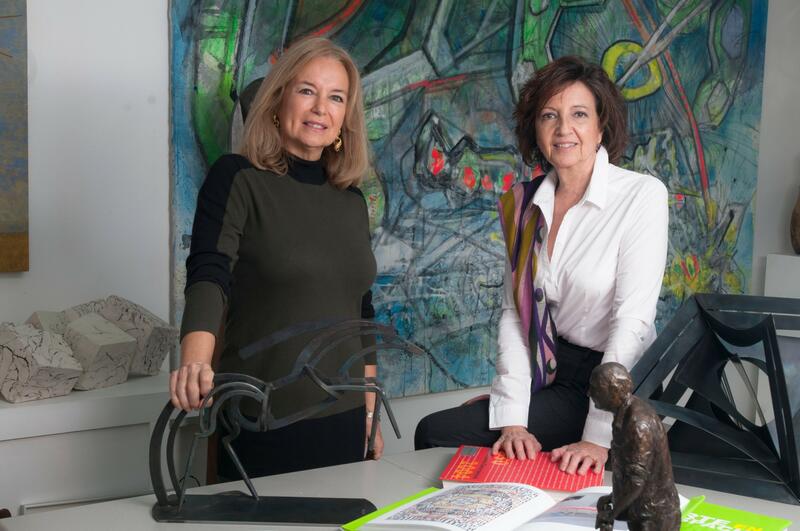SANTIAGO DE CHILE - ARTESPACIO GALLERY: CONTEMPORANEITY AND TRAJECTORY
The Chilean gallery ARTESPACIO was founded in 1995. Its directors, María Elena Comandari and Rosita Lira, have aimed to present, promote and market contemporary Chilean and foreign artists, encouraging collecting and the circulation of art.

Next, an interview with the directors. Questions elaborated together with the curator Max Hernández Calvo
Why did do you decide to have a gallery?
Having an art gallery is the result of a deep love and interest in art.
Being able to dedicate yourself to spreading the work of artists that interest you is a gift; You do it with pleasure without thinking that you are working hard and dedicating your time. Having an art gallery means so many things, it is a global work -from knowing the artist in depth to spreading his works in an exhibition that shows his value and talent- and, at the same time, to show it in an extensive matter so as to bring it closer to the public.
Both directors already had experience in art work, so we founded Artespacio in 1995 and in full force.
When you started as gallery owners, what idea did you have of the art market?
The art market was quite weak in the 1990s and we set out to improve what was even worse: that of sculpture.
Chile was always a country of great sculptors, but at that time it was very difficult to sell it although it was appreciated by the public. After a few years of strongly promoting it, there was a reaction. Little by little, people began to fall in love with three-dimensional artistic work and to embrace the idea of living with it. They put it at the entrance of their houses, in the gardens, offices, buildings; in short, sculpture became essential.
We are dedicated to placing it in the public space, organizing symposia, contests and everything imaginable to improve the art market, happily with good results.
To what extent did that initial idea change compared to the reality of the gallery's day-to-day life and over the years?
The work of a gallery is always long-term, therefore we saw to the most urgent needs: how to interest potential clients, entrepreneurs, students from young people. This meant that the audience increased mainly among young people, inviting guided tours with the artist, communicating art works on all available platforms, and opening our doors for school students to come with their teachers.
You don't need to be knowledgeable in art to visit a gallery, just look and observe, that's the most important thing. And that sparked a different interest.
With regard to sculpture, we work with the idea of“bringing art to the streets”, carrying out many projects in public and private spaces. We wanted people to be able to live with the culture and get to know their artists.
What milestone would you highlight in your experience as a gallery owners?
Actually, each project is unique, they are each cared for as something special. Exhibitions such as Matta, Negret, Jesus Rafael Soto were of a high level.
The sculpture project in Américo Vespucio Cristal 2000 was a landmark in the city of Santiago. Carrying out the sculpture project for Ciudad Empresarial and later the symposia there, was a huge challenge, we had sculptors from all over the world. The Sculptural Walk of the Paseo de la Pastora, is a great challenge for both you and the participating artists.
We also consider important our edition of books, which has been a way to publicize the work of artists, in addition to having excellent texts by critics and curators.
What criteria define your program as a gallery? What artists do you represent, what kind of art do you show, what kind of exhibitions do you organize, and what are the events in which you participate?
We are a gallery of Contemporary Art, we have a committee where we evaluate the projects presented by the artists. We have young artists that many times we choose from our Young Artespacio Contest, that we carry out every year. We are interested in their approaches and the use of new materials. We also work with a selected group of mid-career artists and consecrated ones. We seek excellence and forceful proposals.
Seeking to internationalize the career of Chilean and foreign artists, the gallery regularly participates in prestigious fairs such as Art Miami, Arco, ArteBA, Pinta Miami and Art Lima, among others.
In the face of this global quarantine situation, what are you doing to keep your spirits up, the outreach activity, the commercial activity?
First, maintain communication with the people who work with us, we elaborated a work and communication plan through the networks and platforms. Information is planned each week. For example, the Benjamin Ossa exhibition had just opened when social distancing started, so a virtual visit to the expo was prepared. We keep our public informed on all channels and platforms and give educational information on the artists in the gallery. This is sculptor’s week. We want to give another point of view that keeps up the spirit of the people, art helps to have another perspective.
What changes can this crisis generate in the functioning of the artistic scene?
We believe that there will be a substantial change in every aspect, economically we are analyzing the issue to optimize resources: A very good use of platforms to invite the public into a closer look of our exhibitions and artists, for example.
The decrease in sales (and the flow of clients) will be greatly affected, we are reorganizing ourselves to find ways to continue operating and encouraging people to buy and see art. Among some ideas, we will be virtually opening the exhibitions that we already have scheduled. We cannot remain passive and we must take advantage of this moment.
María Elena Comandari and Rosita Lira


